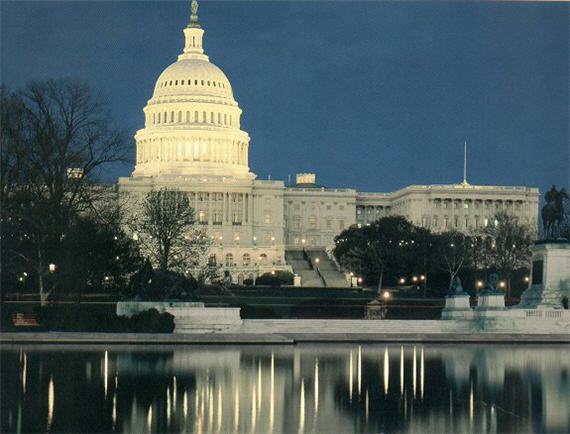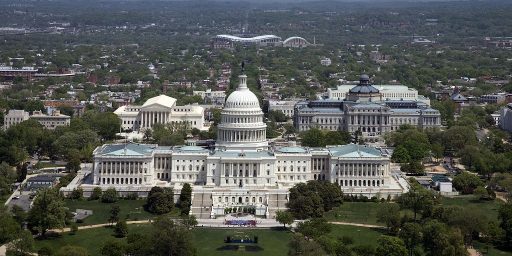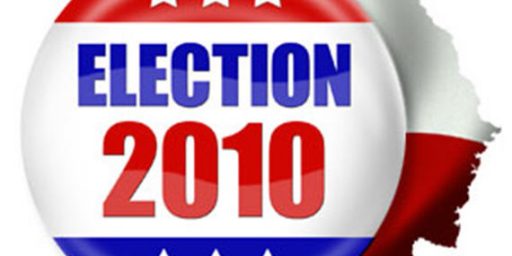Trust In Congress Hits All-Time Low, Both Parties Despised
Public trust in Congress is at an all time low, again, and the public doesn't trust either party to fix things.
A new Gallup poll shows that public confidence in the Legislative Branch has hit it’s lowest level since the 1970s:
A record-low 36% of Americans have a great deal or fair amount of trust and confidence in the legislative branch of government, down sharply from the prior record low of 45% set last year. Trust in the judicial branch and trust in the executive branch also suffered sharp declines this year but remain higher than trust in the legislative branch.
Here’s the chart that tells the story, not just for Congress but for all three branches of government:
As you can tell from the chart, with the exception of understandable post-Watergate distrust of the Executive, trust in all three branches of government seems to have started declining at some point in the 1990s:
Trust in the legislative branch was highest, at 71%, in May 1972, and remained generally high from that point to the mid-2000s. It then dropped to 50% in 2007, 47% in 2008, and 45% in 2009, all record lows at the time they were measured. This year’s 36% legislative confidence rating marks still another record low, and is the lowest trust level in any of the three branches of government in Gallup’s history.
Trust in the executive branch has shifted up and down with some frequency over the last four decades, generally in sync with movement in presidential job approval ratings. Gallup measured the lowest level of trust in the executive branch, 40%, in April 1974, in the midst of the Watergate scandal, which later that year resulted in Richard Nixon’s resignation. Trust was nearly as low in the waning years of the George W. Bush administration. Last year, the first year of the Barack Obama administration, trust in the executive branch shot up to 61%, but it has fallen back again this year, coinciding with the fall in Obama’s job approval ratings to below 50%.
Trust in the judicial branch of government is at 66%, down from last year but roughly in line with readings since 2003. Gallup recorded the highest judicial branch trust reading, 80%, in February 1999, at about the time the Supreme Court’s Chief Justice William Rehnquist was presiding in the U.S. Senate over the impeachment trial of President Bill Clinton.
The fact that the Judiciary is still held in relatively high esteem compared to the other branches of government is largely due to the fact that it is branch of government that is the most insulated from the public, as a I noted back in June when discussing the public’s knowledge about the Supreme Court:
Outside of confirmation hearings, Supreme Court Justices do their work outside the view of the public and even when a controversial or highly publicized decision is issued, it comes from a collective body and is communicated by reporters rather than the Justices themselves. Unlike, say, people who don’t have enough awareness of politics to identity their Federal or state representatives, the fact that large numbers of Americans don’t know who Stephen Breyer or Anthony Kennedy might be is neither surprising or concerning. One imagines that these numbers would change, though, if the Court ever did accept the long-discussed idea of cameras in the courtroom.
In this case, public ignorance inures to the judiciaries benefit.
Getting back to Congress, though, the general disdain for Congress isn’t necessarily good news for Republicans:
In an Associated Press-GfK Poll this month, 60 percent disapprove of the job congressional Democrats are doing — yet 68 percent frown on how Republicans are performing. While 59 percent are unhappy with how Democrats are handling the economy, 64 percent are upset by the GOP’s work on the country’s top issue. Just over half have unfavorable views of each party.
So, despite the fact that polls continue to indicate that Republicans will make gains in November, perhaps even huge gains, the reality of the situation is that we’re living in a country where the general public has no confidence in the body that was established by the Founders to represent them, and don’t trust either party to fix it.
That’s a recipe for…………something. I’m not quite sure what it is, but I don’t think it’s healthy.








Leadership in Black Robes, Let’s see Roe admitted she lied, Church and State not
Constitutional, Two Hundred or More years of Tradition out the Door. They endlessly hear arguments about Freedom of Speach, Gun Rights it’s a revolving (Let’s see what Sticks) Door. Latest appointment “Ideological Neutral”?
What… a… shocker! haha
I think this is a combination of a lot of things. The graph does not go back far enough for me to make my case. But I think after WW2, the serviceman came back home and we had factories that supplied the world. You had unions and as long as there was no outside influences the middle class had upward movement. Since the seventies we had more welfare type of programs, we won the cold war but we could not adjust to a changing world in which third world countries was becoming more capitalistic. The political parties have dug in with their ideologies and they are not solving problems of globalization, fixing social programs, energy independence, or infrastructure. We have lost the upward movement for the middle class and the country seems to be fragmented. There is no cohesiveness anymore. And you have TV and radio gurus who think it is better to run the country to a far fringe and all of this is splitting up the country for their benefit with no pragmatism and the middle class is losing and being ignored.
Is there data missing from that chart? The lines from 1976 to 1997 are suspiciously straight.
Yes, as Russell points out, this is another bad graph. Bad in a different way. There’s no way data for 20 years could form such a consistent trend. So, some idiot connected dots that should not have been.
I’ll grant that the Supreme Ct. does not have its own TV channel. Nor does it allow cameras to cover argument. But it’s still very transparent when it comes to its cases. A little bit of searching–or just going to one of the blawgs that cover the SC–and you find links to transcripts of the arguments as well as all the briefs. The SC’s own site provides most of it as well and does post its opinions, in full, within 15 minutes of announcing the decisions.
If there’s ignorance about it, I’m inclined to think it willful ignorance.
<blockquote>As you can tell from the chart, with the exception of understandable post-Watergate distrust of the Executive, trust in all three branches of government seems to have started declining at some point in the 1990s</blockquote>
All three lines appear to be going up until roughly the 20001-2003 time frame. I’d suggest that most of this is a post-9/11 phenomenon.
The gallup page says they only started asking t his question annualy in the latre 90s. So the straigh line is just ths connection of two polls with many years apart.
I expected about as much. I don’t think that completely invalidates the chart, but it does somewhat reduce its utility.
Are you kidding? The thing which most draws the eye in that chart, it’s principal message (stable improvement for 20 years), is an artifact. It is not truth.
If, as we can guess, the chart had been all over the place in those 20 years, we’d take away a different message.
(The chart asserts a “low” for the legislative branch now, but didn’t test (say) during the Carter years.)
The chart asserts noyhing; it just presents data. As such, it’s still useful, if misleading. It would be better if the straight line trend were represented as a break or, say, a dashed line, however.
However, with the gap in data acknowledged, this chart supports the claims asserted – but only very weakly.
Russell, I could start with the human brain or the chart. Both bear to the problem.
On the brain side, humans are visual creatures. They look for stories in the images they see. If there is a long straight trend in the middle of a graph, they will take that as a strong part of the story. They cannot help themselves. See the raft of illustrations on vision and cognition:
http://en.wikipedia.org/wiki/Optical_illusion#Cognitive_illusions
On the chart itself, if writing is communication, then chart-laying is also, visual, communication. The chart maker has his choices as much as the wordsmith. For this reason words, and charts, can both be read critically.
A chart with connected dots is called a “Line Graph” and its use is recommended to illustrate “Trends, Functional Relations.”
http://www.sapdesignguild.org/resources/diagram_guidelines/charts_bk.html
When you don’t have continuous data, you use a “Scatterplot” to show “Distribution of data points along one or two dimensions.”
So, did the chart maker just use a charting package without thinking? Or did they choose it to give a false impression?